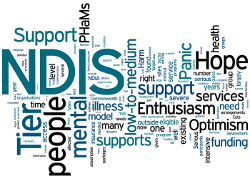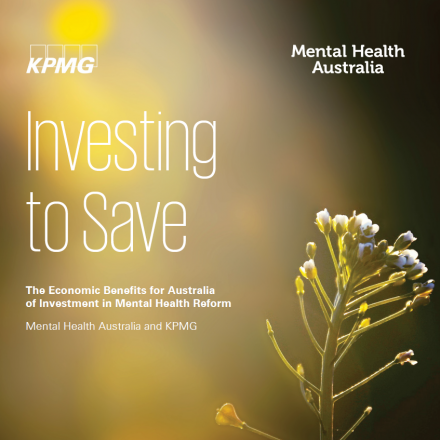Enthusiasm and panic—the NDIS roll-out in mental health
 Feature Story by David Meldrum, Executive Director, Mental Illness Fellowship of Australia
Feature Story by David Meldrum, Executive Director, Mental Illness Fellowship of Australia
Enthusiasm
This is a story about how experience, hope and optimism, usually a good mixture to guide us, may have led us astray, with people affected by serious mental illness and their families the potential losers.
Tier 3 of the National Disability Insurance Scheme (NDIS) is being implemented in several trial sites as I write. To turn first to who Tier 3 is aimed at, in summary they are people with a current diagnosis of severe and persistent mental illness and associated permanent functional disabilities. In other words, the most disabled minority of the several hundred thousands of Australians with these mental illnesses. Typically over the past decade or so, people from this group who are known to providers have been found to need intensive packages of support, costing anything up to $100,000 a year.
Nationally, it is estimated by the NDIA that 57,000 people are eligible for Tier 3, and we all agree that is only a best guess. Whatever the number is, we can’t know how many people will be reached or even want to be reached with an offer of support, or how many will need that intensive level of support at any one time. But 57,000 is a well-informed guess that we can all subscribe to for now.
Since the combined efforts of all state and territory health and community systems have delivered well under 10,000 such packages - probably as few as 5,000 - the wider mental health sector has enthusiastically welcomed the NDIS promise to complete the job of finding and offering the right supports to up to 57,000 people.
We have also generally accepted the notion of an insurance model being the right one for Tier 3. Greater choice and control for participants, individualised funding, with a lifelong entitlement if necessary, and market mechanisms to ensure value for money all make sense to most of us, especially given the very large amounts of funding involved.
We still have some serious arguments about language, the apparent lack of focus on carers, and aspects of assessment processes, but given the shared objective of finally meeting the needs of this most disadvantaged group, in general we are keen to work with the National Disability Insurance Agency (NDIA) constructively to help get the job done over the next few years. We certainly accept that collectively we have not done nearly well enough to date, and that we will not make a serious dent in the appalling housing, education, employment and physical health outcomes for people with this level of disability until we do.
Panic–then we found out how this was to be paid for
Around March 2013, after most of the working groups and key consultations had finished and the legislation was before Federal Parliament, we began to find out what was in the ‘bilaterals’—the NDIS funding agreements between the Commonwealth and most jurisdictions. Specifically, we found out that the majority of funding for current non-clinical mental health support services, both Commonwealth and state/territory, was to be committed to the NDIS implementation.
Two aspects of this alarmed the sector immediately. First the assumption that this funding was currently mainly providing services to Tier 3-eligible people. Second that the insurance model was the right one for all low-to-medium supports outside Tier 3. More on the insurance model later.
The immediate issue was the assumption that programs such as PHaMs (Personal Helpers and Mentors) and many others, both Commonwealth and state/territory funded, would not be needed, because most of the people affected people would find the services they needed in Tier 3 of the NDIS. We all knew this was wrong, and our anxiety doubled when we heard that anybody not in Tier 3 would receive only ‘information and referral to mainstream services’ - not ‘hands-on’ individual, group and family supports.
This definition of Tier 3 – and more importantly the proposed funding arrangements outside Tier 3 - threatens access to existing supports for a large number of Australians, which we estimate at more than 200,000 people, of whom something like 25% will be in need of support at any given time.
Some of these funds are being redirected now and much more is scheduled for 1 July 2015, even though all key players appear to recognise the importance of intermittent access to existing supports for 200,000 people outside Tier 3 who live with serious mental illness. Ministers, senior public servants, parliamentary committees and NDIA Board members that I, and many others, have met with have all been saying they recognise the case for expanding these low-to-medium level supports, because they are:
- Recovery focussed
- Effective
- Preventative
- Efficient
- “Whole of Family” focussed
- Largely participant driven, and
- In the main, hugely popular.
Earlier this year (2014) we were confident that arrangements to ‘protect and expand’ low-to-medium supports would emerge, largely because this was the expressed wish of both the Board Chair and CEO of the NDIA. But this has not happened yet – and time is running out.
In Vic, ACT and soon NSW, the re-direction of funding into Tier 3 has begun. In Victoria, for 15 years the leader in this field, the emerging situation appears to amount to a disgraceful retreat from what have been the benchmark service standards. Whether this is all due to their specific NDIS bilateral is unclear, but the withdrawal of access to low-to-medium supports alarms all of us.
Personal Helper and Mentors (PHaMs)
I will expand about PHaMs because it is one of the few consistent service types across the country, and is very well known.
In 2005, the Budget included the announcement that:
“The Government will provide $284.8 million over five years (including $84.6 million in 2010-11) to engage 900 personal helpers and mentors to assist people with a mental illness who are living in the community to better manage their daily activities. People with a severe mental illness will be assisted in accessing the range of treatment, income support, employment and accommodation services they need.”
(You see here the problems with language that bug us constantly in mental health—mental illness in one sentence, severe mental illness in the next but supposedly for the same target group. Luckily the detailed guidelines for PHaMs were much clearer.)
The program was subsequently expanded in 2011 and 2013.
There are now 175 PHaMs programs operating across Australia, 95 in metropolitan sites, 69 in non-metropolitan sites, and 11 in remote sites
The 2010 national evaluation, and the collective knowledge of program managers and staff, strongly suggest that as many as 80% of the participants of PHaMs programs will not be found eligible to receive a Tier 3 NDIS package of support. This is not a surprise - in fact it fits perfectly with the target groups for which PHaMs was designed - transition to recovery with low-to-medium supports for the short to medium term, with the option to exit and return as needs change.
It is also easy to locate this service offering in the schema adopted by the Productivity Commission in its development of the NDIS, on advice from it auditors in 2012. PHaMs is largely not in the bottom row of this table, which is Tier 3.
|
Description |
Care Needs |
NDIS coverage |
|---|---|---|
|
Episodic mental illness (est. 321,000 people) |
Clinical services both during episodes of illness and to maintain remission between episodes Disability support services may occasionally be required, particularly during a lengthy episode of illness
|
Not included Not included |
|
Severe and persistent mental illness but can manage own access to support systems (est. 103,000 people) |
Clinical services Social inclusion programs |
Not included |
|
Complex needs requiring coordinated services from multiple agencies (est. 56,000) |
One on one support from a carer (paid) Supported accommodation, where appropriate Clinical services Social inclusion programs |
Included Included Not included Included |
The two groups outside Tier 3 are not ‘the worried well’ - they are all dealing with severe mental health issues - and it is our well-educated guess that about half of them (half of the total of 424,000) will need ‘hands on’ assistance from time to time, largely of the low-to-medium support type that have developed over the past 10-15 years.
We have been hearing that this estimate, of only about 20% of PHaMs participants being eligible for Tier 3, is wrong, and examples are quoted of people getting small packages of a few thousand dollars a year. If that is so, it is prima facie evidence of program drift—because by definition people who don’t need intensive levels of support should not be in Tier 3. This is not evidence of ‘nothing to worry about’ - it is potentially an unsustainable mis-allocation of scarce resources away from the very people Tier 3 is designed for.
The insurance model outside Tier 3
This model is not right for low-to-medium supports, because it assumes long term commitment and a market model including payment on proof of service. Such arrangements usually tend to favour:
- formal assessment by a third party before being found eligible
- decisions at a point in time about long-term entitlements and designated types of activity, and
- well cashed-up organisations with comprehensive service offers and sophisticated information and accounting systems—ie. larger organisations.
The right model for low-to-medium support services is the existing one - block funding. Modern services in this sector are generally characterised by:
- easy access with minimal assessment
- flexibility to ‘start where the client is at’
- capacity to ‘flex’ the level and type of support from minimal to intensive
- ready access for the participant’s family to be part of the recovery focus
- significant numbers of peers among the staff—people with mental illness and carers
- relatively short-term engagement—PHaMs averages a little over one year
- minimal workforce shortages and high retention rates, and
- inclusion of a wide range of providers, many of which are ‘grass-roots’ and quite small organisations.
Summary
All of us who have been part of the long battle to deliver the right types of assistance to people affected by severe mental illness and the associated disabilities have welcomed the promise of Tier 3 of the NDIS. This is a once-in-a-generation opportunity to complete the processes we set in motion over 20 years ago when the main wave of ‘de-institutionalisation’ was achieved.
However, the assumption that many existing services will not be needed when Tier 3 is fully implemented is wrong. Australia needs Tier 3 in addition to existing low-to-medium level supports, not instead of them. If that can be agreed on, we can all collaborate in several key ways:
- Keep talking constructively about the number of people in Tier 3 – settle on a number for now but keep it under continuous review
- Ensure ‘mission creep’ does not happen with Tier 3 - stick to the target group of people in need of ongoing intensive support
- Genuinely engage with people who may or may not be eligible for Tier 3, and
- Act urgently to protect and grow existing low-to-medium support services.
Our enthusiasm regarding the NDIS and mental health has been and will continue to be based on successful implementation of Tier 3. Our rising panic about wholesale and largely unnecessary upheaval and funding cuts for low-to-medium level services remains. One out of two is not going to be good enough.
__________
Do you have a comment on this story? Join the conversation on Twitter @AUMentalHealth


 Feature Story by David Meldrum, Executive Director, Mental Illness Fellowship of Australia
Feature Story by David Meldrum, Executive Director, Mental Illness Fellowship of Australia

